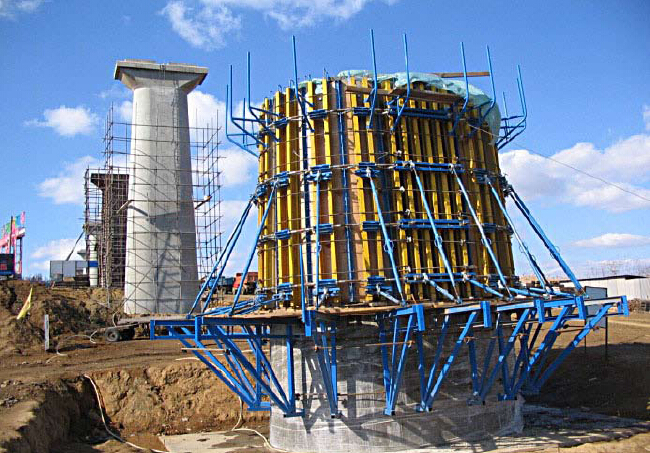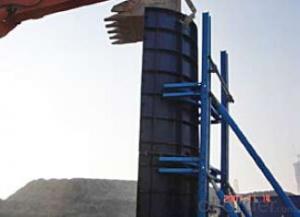Building Bridge Tunnel Formwork and Scaffolding System
- Loading Port:
- Tianjin
- Payment Terms:
- TT OR LC
- Min Order Qty:
- 50 m²
- Supply Capability:
- 1000 m²/month
OKorder Service Pledge
Quality Product, Order Online Tracking, Timely Delivery
OKorder Financial Service
Credit Rating, Credit Services, Credit Purchasing
You Might Also Like
Building Bridge&Tunnel Formwork:
A compositional steel formwork system mainly used in the building which has regular structure
without beams, the excellent formwork system can make the integral pouring for the wall & slab
easily achieved.
Characteristics:
◆ No assembling, easy operation with formed formwork.
◆ High stiffness, make perfect shape for concrete.
◆ Repeatedly turnover is available.
◆ Widely applied range, such as building, bridge, tunnel, etc.

- Q:How does steel formwork handle concrete pouring in cold weather?
- Steel formwork is a preferred choice for concrete pouring in cold weather due to its durability and ability to withstand extreme temperatures. It acts as a protective barrier against freezing temperatures, preventing the concrete from freezing too quickly, which could lead to weakened structures. The steel formwork also helps to retain heat generated during the concrete curing process, ensuring proper and consistent curing even in colder conditions.
- Q:How does steel formwork affect the overall strength of the structure?
- The overall strength of a structure can be greatly enhanced by steel formwork. Steel, known for its exceptional strength and durability, is an ideal material for formwork. When used in construction, steel formwork creates a rigid framework that bears the weight of the concrete during pouring and curing. The utilization of steel formwork guarantees proper containment and support for the concrete, preventing any deformation or collapse during the hardening phase. This is essential for maintaining the structural integrity of the building, as any failure in the formwork can have serious consequences. Additionally, steel formwork offers greater design flexibility as it can be easily customized and shaped to fit the desired structure. This versatility empowers engineers and architects to create intricate and innovative designs without compromising the building's strength. Furthermore, steel formwork has a longer lifespan compared to other formwork materials like wood or plastic. Its durability allows for multiple reuses, reducing construction costs and minimizing waste. This not only makes it cost-effective but also contributes to sustainability in the construction industry. In conclusion, steel formwork positively impacts the overall strength of a structure by providing a robust and reliable support system for the concrete. Its strength, durability, and flexibility make it an excellent choice for ensuring the structural integrity and longevity of buildings.
- Q:What are the different material handling requirements for steel formwork?
- Steel formwork offers numerous advantages in construction projects, such as its durability, reusability, and ability to withstand high pressure and loads. However, it is important to consider specific material handling requirements associated with steel formwork. Firstly, when handling and transporting steel formwork panels, it is crucial to use suitable lifting equipment like cranes or forklifts. This ensures that the load is evenly distributed and reduces the risk of dropping or damaging the panels during transportation. Secondly, proper storage is essential to prevent rust and corrosion. The panels should be stored in a dry and well-ventilated area. Additionally, they should be stacked evenly to avoid deformation. It is important to stack them in a way that allows easy access to individual panels without causing damage to others. Regular cleaning and maintenance are necessary to ensure the longevity and reusability of steel formwork. After each use, the formwork should be cleaned to remove any concrete residue, dirt, or debris. Additionally, it is important to inspect the formwork for any signs of damage, such as cracks or bends, and repair or replace them as needed. Skilled workers are required for the proper assembly and disassembly of steel formwork. The panels need to be accurately aligned and securely connected to form a watertight structure. During disassembly, care should be taken to avoid damaging the panels, ensuring they can be reused in the future. To enhance the durability and lifespan of steel formwork, surface protection measures should be taken. This includes applying anti-corrosion coatings or paint to prevent rust and corrosion. Regular inspections should be conducted to identify any signs of damage or deterioration on the surface, and necessary actions should be taken to maintain the integrity of the formwork. In conclusion, adhering to the material handling requirements for steel formwork, such as proper handling and transportation methods, appropriate storage and stacking, regular cleaning and maintenance, skilled assembly and disassembly, and surface protection measures, is essential for optimal performance and longevity in construction projects.
- Q:Does steel formwork require any special training or expertise for installation?
- Yes, steel formwork typically requires specialized training and expertise for proper installation. Steel formwork involves working with heavy and rigid materials, as well as understanding the intricacies of its assembly and dismantling process. Adequate knowledge of safety precautions, structural design, and handling equipment is crucial to ensure a successful and secure installation.
- Q:Can steel formwork be used for different types of concrete finishes?
- Yes, steel formwork can be used for different types of concrete finishes. Steel formwork is versatile and can be easily adjusted and customized to achieve different finishes, such as smooth, textured, or patterned surfaces. It provides a strong and rigid structure, allowing for precise shaping and detailing of the concrete. Additionally, steel formwork can be reused multiple times, making it cost-effective for various types of concrete finishes.
- Q:Can steel formwork be used for both small-scale and large-scale projects?
- Steel formwork is suitable for both small-scale and large-scale projects. It is highly adaptable and can easily be tailored to fit different project sizes and requirements. With its exceptional strength and durability, steel formwork is ideal for large-scale projects involving heavy concrete structures. Moreover, it can be reused multiple times, making it a cost-effective option for projects of any size. Its inflexible structure guarantees precise concrete placement, which is crucial for achieving top-notch results in any project. Therefore, whether it's a small-scale residential construction or a large-scale commercial development, steel formwork is a dependable choice for the successful implementation of concrete works.
- Q:How does steel formwork handle concrete curing compounds and sealers?
- Steel formwork is highly resistant to concrete curing compounds and sealers. Due to its non-porous surface, steel formwork prevents the penetration of these chemicals, ensuring that they do not interfere with the curing process or affect the quality of the concrete. Additionally, steel formwork is easy to clean and maintain, allowing for efficient removal of any residual compounds or sealers that may come into contact with it during construction.
- Q:Does steel formwork require any special expertise or training for installation?
- Installation of steel formwork necessitates specialized expertise and training. Steel formwork comprises intricate interlocking panels and components that serve as temporary molds for pouring concrete structures. It demands a comprehensive grasp of formwork design, installation techniques, and safety protocols. Professionals who engage in steel formwork must possess in-depth knowledge of project-specific prerequisites, including load-bearing capacity, formwork connections, and appropriate reinforcement placement. They must also be capable of accurately measuring and cutting steel panels, assembling them correctly, and ensuring proper alignment and bracing of the formwork. Additionally, proficiency in steel formwork installation entails familiarity with various formwork systems, such as adjustable steel formwork, modular steel formwork, or tunnel formwork. Selecting the most suitable system for a given project is paramount. This knowledge is critical to guarantee that the formwork can endure the pressure exerted by wet concrete and yield a structurally sound and visually appealing end result. Furthermore, comprehensive training in steel formwork installation is indispensable to ensure the safety of workers and the overall success of the construction endeavor. This encompasses understanding safety regulations, employing personal protective equipment effectively, and being mindful of potential hazards and their mitigation methods. In conclusion, given the intricate nature and specific requisites of steel formwork installation, it is imperative to enlist professionals possessing the requisite expertise and training to facilitate a streamlined and prosperous construction process.
- Q:How does steel formwork handle formwork stripping and demolding?
- Known for its durability and strength, steel formwork is an exceptional option for managing formwork stripping and demolding. The advantages of steel formwork in the formwork stripping process are numerous. To begin with, steel formwork is equipped with a sleek surface that enables the effortless removal of cured concrete. This smooth surface decreases the likelihood of concrete adhering to the formwork, simplifying the stripping process without causing any harm to the structure. Additionally, steel formwork is typically constructed with a system of detachable joints and connections, facilitating efficient formwork stripping. These joints and connections are designed to be easily separated, allowing for swift and uncomplicated removal of the formwork. This feature is particularly advantageous for large-scale construction projects where time is of the essence. Moreover, steel formwork exhibits high resistance to deformation and warping, ensuring that the formwork maintains its original shape during the stripping process. This resistance to deformation helps prevent any distortion or damage to the concrete structure during the demolding phase. Furthermore, steel formwork offers excellent reusability, further enhancing its efficiency in handling formwork stripping and demolding. Once the formwork is stripped, it can be cleaned, repaired if necessary, and reused for subsequent concrete casting. This reusability not only saves time and money but also reduces the environmental impact associated with formwork disposal. In conclusion, steel formwork is specifically designed to handle formwork stripping and demolding effortlessly. Its smooth surface, detachable joints, resistance to deformation, and reusability make it a dependable and efficient choice for construction projects.
- Q:Can steel formwork be used for projects with high concrete durability demands?
- Yes, steel formwork can be used for projects with high concrete durability demands. Steel formwork is renowned for its strength, stability, and ability to withstand repeated use. It provides a smooth and even surface finish to the concrete, ensuring high-quality results. Additionally, steel formwork is resistant to warping or distortion, which can affect the durability of the concrete structure. Thus, it is a reliable choice for projects that require high concrete durability.
1. Manufacturer Overview |
|
|---|---|
| Location | |
| Year Established | |
| Annual Output Value | |
| Main Markets | |
| Company Certifications | |
2. Manufacturer Certificates |
|
|---|---|
| a) Certification Name | |
| Range | |
| Reference | |
| Validity Period | |
3. Manufacturer Capability |
|
|---|---|
| a)Trade Capacity | |
| Nearest Port | |
| Export Percentage | |
| No.of Employees in Trade Department | |
| Language Spoken: | |
| b)Factory Information | |
| Factory Size: | |
| No. of Production Lines | |
| Contract Manufacturing | |
| Product Price Range | |
Send your message to us
Building Bridge Tunnel Formwork and Scaffolding System
- Loading Port:
- Tianjin
- Payment Terms:
- TT OR LC
- Min Order Qty:
- 50 m²
- Supply Capability:
- 1000 m²/month
OKorder Service Pledge
Quality Product, Order Online Tracking, Timely Delivery
OKorder Financial Service
Credit Rating, Credit Services, Credit Purchasing
Similar products
New products
Hot products
Related keywords
























